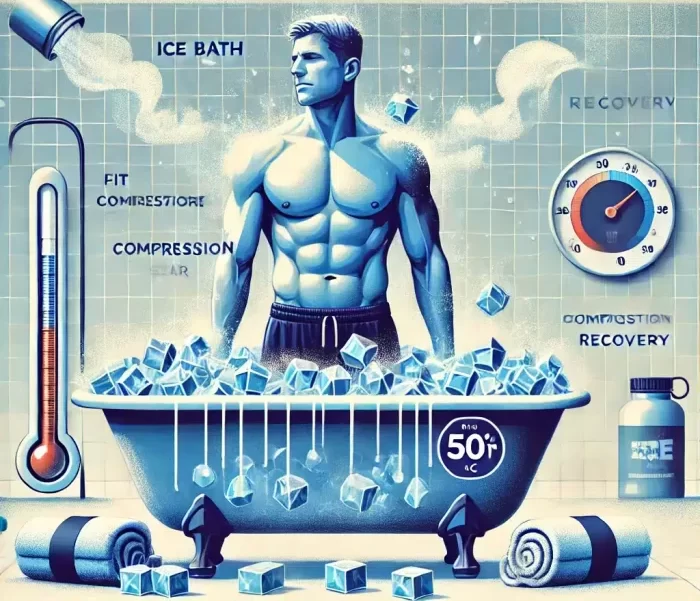How Cold Is an Ice Bath? The Ideal Temperature and Benefits Explained
Athletes, biohackers, and recovery junkies swearing for their benefits have helped ice baths become well-known in the fitness and wellness scene. An ice bath can be a revolution whether your goals are to increase mental resilience, speed up muscular recovery, or stimulate circulation. To gain the most advantages without damage, how chilly should an ice bath be?
The efficiency of an ice bath depends critically on its temperature. Too heated, and you will not profit from it. Too chilly, and you run the danger of being uncomfortable, shocked, or even hypothermic. The proper balance can help lower inflammation, aid in muscle repair, and even stimulate brown fat—which can help control metabolism. Going too far, in the meantime, can cause numbness, too much cooling, and even tissue injury.
The appropriate temperature for an ice bath will be broken out in this article together with the reasons behind it and safe ways to include cold treatment into your regimen. Understanding the science and best practices can help you to make sure your ice baths are both safe and powerful.
How Cold Is an Ice Bath?
Usually running between 50°F and 59°F (10°C and 15°C), an ice bath is Most people agree that this temperature range is the ideal one for lowering muscle pain, boosting circulation, and inducing physiological effects including brown fat activation. It doesn’t unnecessarily endanger the body while also giving enough cold exposure to stimulate recovery systems.
Extreme athletes and certain expert cold therapy practitioners, however, drop the temperature to 40°F (4°C) or even below. Although this might boost the body’s cold adaption response, if improperly controlled it greatly increases the chances of cold shock, too strong vasoconstriction, and even frostbite.
Comparing Different Ice Bath Temperatures:
- Though still cool and revitalizing, 60°F (15°C) and above does not offer the full advantages of cold exposure.
- The optimal range for most people, 50–59°F (10–15°C), is efficient for recovery free from too great risk.
- A more extreme cold exposure, 40–49°F (4–9°C), results in faster metabolic activation and vasoconstriction but calls for greater experience and caution.
- Mostly not advised below 40°F (4°C). This level is only appropriate for experienced people under expert direction since cold shock, numbness, and hypothermia are somewhat common hazards.
Knowing these variances will enable you to modify your ice bath experience depending on your tolerance, objectives, and safety concerns.
Why Does the Temperature Matter?
An ice bath’s temperature directly influences how your body reacts to cold exposure; it is not just a number. Various temperature ranges stimulate diverse physiological reactions, some of which can be good and others of which might raise risk.
You may still feel the cooling impact when the water is too warm—above 60°F/15°C—but your body won’t undergo the same degree of vasoconstriction—narrowing of blood vessels—that helps lower muscle stiffness and inflammation. Furthermore lacking is the cold-induced thermogenesis pathway, necessary to activate brown fat and boost calorie burning.
The ideal range, 50 to 59°F/10 to 15°C, lets the body recuperate without too much trauma. This level of cold exposure sets off norepinephrine, a hormone connected to lower inflammation and better focus. Cold water immersion in this range improved post-exercise muscle repair and lowered muscular fatigue, according to a study in The Journal of Applied Physiology.
Below 50°F (10°C), more intense cold stress is introduced, which can stimulate brown adipose tissue (BAT) and offer more metabolic advantages. This does, however, also tax the neurological system harder and raise the likelihood of numbness and too strong cooling. Extreme cold exposure could cause stress if not controlled, according to a study in The European Journal of Applied Physiology, which indicated that cold immersion below 45°F (7°C) greatly boosted cortisol levels but also greatly enhanced metabolic rate.
Hypothermia becomes a significant hazard in the danger zone (below 40°F/4°C), and extended exposure can cause cold-induced nerve damage. For optimum benefits and lowest hazards, most experts and researchers advise keeping in the safe zone of 50–59°F (10–15°C).
How Long Should an Ice Bath Be?

Like the temperature, the length of your ice bath counts. While staying in too long can cause dangerously low core body temperature, spending too little time in the cold water may not trigger the whole range of advantages.
Based on your skill level and water temperature, most studies indicate that the best length of time is five to fifteen minutes. Generally speaking:
- Start with 3 to 5 minutes in 55-59°F (13 to 15°C) water, first-timers. This lets your body adapt without too much stress.
- Once comfortable, try 10 minutes in 50-55°F (10-13°C) water to enhance muscle recovery benefits.
- Experience advanced practitioners should stay in for 10 to 15 minutes at 45 to 50°F (7 to 10°C). If you start to feel extreme shaking or numbness, though, you should pay close attention to your body and stop.
Ten-minute ice baths at 50°F (10°C) dramatically lessened muscular pain and inflammation in athletes than shorter durations or higher temperatures, according a study in The American Journal of Sports Medicine.
Still, remaining more than fifteen minutes is not advised—even for experienced ice bath users. Extended exposure can cause cold-induced vasodilation, in which case blood vessels reopen and a rapid flow of cold blood back into the core causes dizziness, fainting, or even hypothermia.
One of the main markers you have been in long enough is under control shivering. Normal mild shivering indicates that your body is trying to create heat. Leave the ice bath right once, though, if you get numbness, confusion, or severe, uncontrollable shivering.
Post-bath warming is another consideration. To restore normal circulation, always warm up progressively by drying off, clothing in warm clothes, and gently moving. Instant blood vessel dilation by jumping into a hot shower right after an ice bath may create lightheadedness or vertigo.
How Much Ice Do You Need for an Ice Bath?
The beginning temperature of the water, the size of your tub or container, and how chilly you wish the bath to be will all affect the amount of ice required. If you use standard tap water, usually between 60 and 70°F (15 and 21°C), you will need a significant quantity of ice to lower it to the recommended range of 50 to 59°F (10 to 15°C).
Based on how cold you wish your ice bath to be, here is a broad guideline:
- Mild Cold (55—59°F / 13–15°C) – Fill a typical bathtub with 10–20 pounds of ice.
- Add 20 to 40 pounds of ice to bring the water to ideal range from 50 to 54°F / 10-12°C.
- Strong cold (45–49°F / 7–9°C) will require 50–70 pounds of ice to preserve this lower temperature.
- Extreme Cold (below 45°F / 7°C) calls for 80+ pounds of ice; this level should only be tried by very experienced cold exposure sufferers.
Start with cold tap water in your tub for best results; then, progressively add ice while keeping a thermometer’s temperature under observation. Before getting in, let the ice cool the water uniformly for a few minutes.
Pre-chilled water is used by some people to cut the ice required. Using frozen water bottles instead of loose ice is another sensible way to help preserve the cold without too much melting.
Investing in a cold plunge tub with built-in temperature control can be a more practical and economical choice than purchasing ice every time if you often take ice baths.
How Many Ice Baths Should You Take Per Week?
Your goals and degree of experience will determine how often you use ice baths. Although some professional athletes swear by daily ice baths, most will gain from a modest and calculated approach to cold exposure.
Based on various goals, below is the frequency you might find reasonable for considering ice baths:
- Two to three times a week is plenty to help with post-workout inflammation and muscular healing for general recovery and soreness. Spacing them out lets your body adjust without taxing your system.
- Some top athletes, particularly following demanding training sessions, take ice baths four to five times a week. It’s advisable to mix ice baths with appropriate recovery strategies, while some studies indicate too much cold exposure may impede muscle adaptation.
- If you use ice baths for mental training and stress adaption, three to four times a week can be quite helpful. Regular controlled cold stress exposure can boost mental fortitude and stress resilience.
- Ice baths increase brown fat activity, but for noticeable fat loss, they should be paired with appropriate diet and exercise. Although three to five ice baths a week could provide some metabolic advantages, general lifestyle choices will affect the results.
If you have never used ice baths, begin one or two sessions a week and note how your body responds. Should you feel too tired, slow, or have residual cold sensitivity, you could have to lower the frequency and let greater recovery between sessions.
How to Safely Prepare an Ice Bath?
Including ice baths into your program calls for great safety. Here’s how to create a correctly balanced ice bath that reduces risk:
1. Choose the Right Temperature
As said before, try for a temperature between 50 and 59°F (10-15°C). If you have never experienced cold exposure, start at the upper end of the spectrum and progressively move down.
2. Use a Thermometer
Never assume the temperature; rather, use a thermometer to make sure the water is safe and efficient. This helps to avoid pointless hazards include severe cold shock or an ice bath too heated for use.
3. Gradually Introduce Ice
Add the ice gradually while monitoring the temperature instead of throwing all the ice at once. This guarantees a uniform dispersion of cold and helps control the cooling process.
4. Control Your Breathing
The first shock of cold water might set off quick, shallow breathing, which makes calm difficult. To engage the parasympathetic nervous system and enable your body to adjust, concentrate on calm, deep breaths inhaled through your nose and out through your mouth.
5. Limit Your Time in the Ice
In an ice bath, even seasoned therapists should not spend more than fifteen minutes. Starting three to five minutes, beginners should progressively increase as their body adjusts.
6. Warm Up Gradually After Exiting
Steer clear of the impulse to dash into a hot shower straight after an ice bath. Rather, dry off fast, dress in warm clothing, and move around creating natural body heat. Your body will progressively come back to normal by light stretching, mild walking, or sipping a warm beverage.
7. Listen to Your Body
Leave the bath right away if you get strong shaking, numbness, vertigo, or confusion. Pushing outside the comfort zone of your body could cause hypothermia, cold shock, or other potentially fatal consequences.
8. Avoid Ice Baths If You Have Certain Health Conditions
Before attempting ice baths, those with nerve-related problems, circulation diseases, or heart illnesses should see a doctor. For certain people, the abrupt temperature drop might strain the cardiovascular system and be dangerous.
Final Thoughts:
Between 50 and 59°F (10–15°C), the ideal ice bath temperature strikes the ideal mix between safety and recovery advantages. Duration counts also; the advised range is five to fifteen minutes. Their efficacy can be improved even more by knowing how often to take ice baths and how much ice to use, therefore reducing dangers.
If you have never used ice baths, start modest and increase your tolerance over time. Whether your use of them is for metabolic advantages, mental resilience, or muscular recovery, knowledge of the science and best practices guarantees a safe and advantageous experience.






